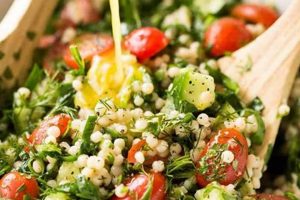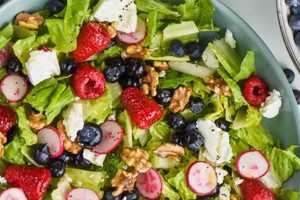A preparation guide for this dish typically involves cooked and sliced whelk (scungilli), combined with a vibrant medley of Italian-inspired ingredients. These often include celery, red onion, parsley, olive oil, lemon juice, and red pepper flakes. Variations might incorporate other elements like cherry tomatoes, black olives, or marinated artichoke hearts.
This chilled seafood salad offers a refreshing and flavorful experience, particularly suited for warm weather. Its historical roots lie in Italian-American cuisine, reflecting the culinary traditions brought by immigrants from Southern Italy, where seafood dishes hold a prominent place. The dish presents a lighter, protein-rich alternative to heavier pasta salads, while offering a unique taste profile that can be both an appetizer or part of a larger meal.
The following sections will delve into specific variations on this classic dish, providing detailed instructions, ingredient lists, and helpful tips for achieving optimal flavor and texture. Nutritional information and suggestions for pairing with complementary dishes will also be explored.
Tips for Preparing Scungilli Salad
Achieving optimal flavor and texture in scungilli salad requires attention to detail. The following tips offer guidance for preparing a truly exceptional dish.
Tip 1: Source High-Quality Scungilli: Canned scungilli is readily available, but using fresh, properly cleaned and cooked whelk elevates the salad significantly.
Tip 2: Precise Slicing: Thinly and uniformly slicing the scungilli ensures a pleasant texture and allows the marinade to penetrate effectively.
Tip 3: Balancing Acidity: The marinade requires a delicate balance of lemon juice and olive oil. Adjusting the ratio according to personal preference enhances the overall flavor profile. Tasting and adjusting is key.
Tip 4: Fresh Herbs: Using fresh parsley, rather than dried, provides a brighter, more vibrant flavor. Other fresh herbs, like oregano or basil, can also complement the salad.
Tip 5: Marination Time: Allowing the salad to marinate for at least one hour, or preferably longer, in the refrigerator allows the flavors to meld and intensify.
Tip 6: Proper Chilling: Serve the salad thoroughly chilled for the most refreshing experience. Avoid letting the salad sit at room temperature for extended periods.
Tip 7: Mindful Ingredient Combinations: While traditional recipes provide a solid foundation, experimenting with complementary ingredients like roasted red peppers, Kalamata olives, or capers can add depth and complexity.
By following these tips, one can create a scungilli salad that is not only flavorful and refreshing but also showcases the quality of its ingredients and careful preparation.
The next section will offer suggestions for serving and pairing this versatile dish to complete the dining experience.
1. Fresh, High-Quality Scungilli
The foundation of an exceptional Italian scungilli salad rests upon the quality of its primary ingredient: scungilli, or whelk. Fresh, high-quality scungilli contributes significantly to the overall taste and texture of the dish, elevating it from ordinary to extraordinary. Understanding the nuances of sourcing and selecting this key ingredient is crucial for culinary success.
- Sourcing and Selection:
Ideally, scungilli should be sourced fresh from reputable fishmongers. Indicators of freshness include a clean, briny scent, firm texture, and a vibrant, opaque appearance. Pre-cooked, canned scungilli offers convenience, but fresh scungilli provides superior flavor and texture. When purchasing fresh scungilli, ensure proper cleaning and preparation techniques are followed.
- Impact on Flavor:
Fresh scungilli possesses a delicate, subtly sweet flavor that complements the bright, acidic elements of the salad. This delicate flavor can be easily overwhelmed by lower-quality or improperly handled scungilli, resulting in a less nuanced and enjoyable dish. The freshness of the scungilli directly influences the overall taste profile.
- Textural Considerations:
Properly prepared fresh scungilli offers a firm yet tender bite, enhancing the textural complexity of the salad. Overcooked or poorly handled scungilli can become tough and rubbery, detracting from the overall dining experience. Careful attention to cooking time and temperature is essential.
- Shelf Life and Storage:
Fresh scungilli is a highly perishable ingredient requiring proper storage to maintain quality. It should be stored in the coldest part of the refrigerator and consumed within one to two days of purchase. Proper storage preserves the delicate flavor and texture, preventing spoilage and ensuring a safe and enjoyable culinary experience.
By prioritizing fresh, high-quality scungilli, one ensures the Italian scungilli salad reaches its full potential. The interplay of fresh flavors and textures creates a harmonious dish that showcases the quality of its ingredients. This attention to detail elevates the salad from a simple appetizer to a memorable culinary experience.
2. Authentic Italian Ingredients
Authentic Italian ingredients are fundamental to capturing the true essence of Italian scungilli salad. These ingredients contribute not only to the dish’s flavor profile but also to its cultural significance. Careful selection and utilization of these components elevate the salad beyond a mere combination of ingredients, transforming it into a culinary representation of Italian heritage.
- Extra Virgin Olive Oil:
High-quality extra virgin olive oil provides the foundation of the salad’s dressing, contributing a distinct peppery fruitiness and richness. Italian extra virgin olive oils, particularly those with protected designations of origin (PDO), offer nuanced flavors reflective of their terroir. This oil emulsifies with the acidic components of the dressing, coating the scungilli and vegetables, enhancing their individual flavors while creating a harmonious blend.
- Red Wine Vinegar:
Red wine vinegar introduces a bright, acidic counterpoint to the richness of the olive oil. Traditional Italian red wine vinegars, often aged in wooden barrels, possess a complex depth of flavor that complements the scungilli. The acidity of the vinegar also helps to tenderize the scungilli and balance the overall flavor profile.
- Fresh Herbs:
Freshly chopped Italian parsley is a staple in scungilli salad, offering a clean, herbaceous aroma and taste. Other herbs, like oregano or basil, may be incorporated depending on regional variations. The use of fresh, rather than dried, herbs is crucial for capturing the vibrant flavors characteristic of Italian cuisine. These herbs brighten the salad, adding complexity to the overall taste.
- Sea Salt and Black Pepper:
High-quality sea salt and freshly ground black pepper are essential seasonings. These seemingly simple ingredients enhance the natural flavors of the scungilli and other components. The correct balance of salt and pepper is crucial, as over-seasoning can mask the delicate flavors of the salad, while under-seasoning can leave it bland.
The synergy of these authentic Italian ingredients is paramount in creating a true Italian scungilli salad. These components work in harmony to produce a dish that is not only flavorful but also reflective of the culinary traditions of Italy. The careful consideration and selection of these ingredients elevates the salad from a simple dish to a genuine culinary experience, offering a taste of Italian heritage.
3. Precise slicing technique
Precise slicing technique is integral to the success of an Italian scungilli salad. Uniformly thin slices of scungilli ensure optimal texture and flavor absorption. Thin slices offer a tender, palatable consistency, contrasting pleasantly with the crisp vegetables. Furthermore, the increased surface area facilitates greater interaction with the marinade, allowing the scungilli to absorb the flavors of the olive oil, vinegar, and herbs more effectively. Unevenly sliced scungilli can result in a dish with inconsistent texture, ranging from tough, chewy pieces to overly thin, almost mushy sections. The marinade also penetrates unevenly, leading to an unbalanced flavor profile.
Consider the difference between thinly sliced scungilli and thickly sliced pieces. Thin slices, approximately -inch thick, readily absorb the marinade, resulting in tender, flavorful scungilli. Conversely, thicker slices may retain a chewy texture and lack the desired depth of flavor. This discrepancy highlights the importance of precision in achieving the desired balance of texture and taste. In a well-executed scungilli salad, each slice contributes to the overall harmony of flavors and textures.
Mastery of precise slicing technique elevates the Italian scungilli salad. This technique ensures even marinade penetration, tender texture, and a harmonious balance of flavors. The practical application of this understanding yields a superior culinary outcome, demonstrating the significant impact of seemingly minor details in achieving culinary excellence.
4. Balanced Marinade
A balanced marinade is crucial for a successful Italian scungilli salad. The marinade not only flavors the scungilli but also tenderizes it and contributes to the overall balance of the dish. A well-balanced marinade harmonizes acidity, saltiness, and aromatics, complementing the natural flavors of the scungilli without overpowering them. An overly acidic marinade can make the scungilli tough and impart an excessively sharp taste. Conversely, a marinade lacking acidity may not adequately tenderize the scungilli or provide the necessary brightness to balance the richness of the seafood. For example, a marinade composed solely of olive oil and lemon juice, without the tempering influence of herbs and seasonings, may result in a one-dimensional flavor profile. The interplay of these elements creates complexity and depth, transforming the scungilli into a more flavorful and texturally appealing component of the salad.
The practical significance of a balanced marinade becomes evident in the final dish. A properly marinated scungilli salad exhibits a harmonious blend of flavors, with the scungilli tender and infused with the aromatics of the marinade. The flavors of the other ingredients, such as celery, onions, and peppers, are also enhanced by the marinade, creating a cohesive and flavorful salad. Consider a scenario where the marinade is overly salty. This excess salt not only overwhelms the delicate flavor of the scungilli but also affects the other vegetables in the salad, creating a dish that is unpleasant to consume. This illustrates the importance of precise measurements and thoughtful consideration of flavor balance in crafting the marinade. The marinade acts as a unifying element, binding the individual components into a cohesive whole.
Achieving a balanced marinade requires careful consideration of ingredient ratios and flavor profiles. The interaction between acidity, salt, and aromatics determines the overall impact on the scungilli and other salad components. Understanding the interplay of these elements allows for informed adjustments, ensuring a marinade that enhances, rather than detracts from, the overall quality of the Italian scungilli salad. The balanced marinade contributes significantly to both the taste and texture of the salad, underscoring its importance in achieving a successful culinary outcome. It is not merely a flavoring agent but an integral part of what makes this dish a flavorful and texturally satisfying experience.
5. Adequate Chilling Time
Adequate chilling time is a critical factor in the overall quality of an Italian scungilli salad. Chilling allows the flavors of the marinade to meld and deepen, enhancing the complexity of the dish. This process also improves the texture of the scungilli, making it more tender and palatable. Furthermore, a chilled salad is simply more refreshing, particularly in warm weather.
- Flavor Development:
Chilling allows the various components of the marinadethe olive oil, vinegar, herbs, and spicesto fully integrate with the scungilli and vegetables. The flavors become more cohesive and nuanced over time, resulting in a more complex and satisfying taste profile. Without sufficient chilling time, the flavors may remain disjointed, lacking the desired depth and harmony.
- Texture Enhancement:
Chilling firms the scungilli, creating a more pleasant texture. The cold temperature also helps to further tenderize the seafood, making it more palatable. A chilled salad offers a refreshing contrast in textures, from the tender scungilli to the crisp vegetables.
- Enhanced Sensory Experience:
A chilled salad is simply more refreshing, especially in warmer weather. The cool temperature enhances the bright, acidic notes of the marinade and provides a welcome contrast to the heat. This contributes to a more enjoyable and satisfying sensory experience.
- Food Safety Considerations:
Chilling helps to inhibit the growth of bacteria, ensuring food safety. Maintaining the salad at a safe temperature below 40F (4C) prevents spoilage and minimizes the risk of foodborne illness. This is particularly important for seafood salads, which are more susceptible to bacterial growth.
The benefits of adequate chilling time extend beyond mere temperature reduction. This crucial step contributes significantly to flavor development, texture enhancement, and overall enjoyment of the Italian scungilli salad. By allowing sufficient time for the flavors to meld and the textures to optimize, one ensures a more refined and satisfying culinary experience. Neglecting this step can compromise the quality and safety of the dish, highlighting the importance of adequate chilling time in achieving culinary excellence.
6. Optional Ingredient Additions
Optional ingredient additions provide a pathway to personalize and enhance the foundational recipe for Italian scungilli salad. These additions, while not essential to the core definition of the dish, offer opportunities to introduce nuanced flavors, textures, and visual appeal, catering to individual preferences and culinary creativity. The judicious incorporation of optional ingredients can elevate the salad from a traditional offering to a signature creation.
Consider the addition of chopped cherry tomatoes. These burst with sweetness and acidity, complementing the briny scungilli and adding a vibrant color contrast. Alternatively, incorporating Kalamata olives introduces a salty, savory element, enhancing the Mediterranean character of the salad. Roasted red peppers, with their smoky sweetness, offer another dimension of flavor complexity. These examples demonstrate the potential of optional ingredients to transform the overall sensory experience. The impact extends beyond mere flavor enhancement; these additions can influence the perceived texture and visual presentation of the salad, adding layers of complexity to the culinary experience.
The strategic use of optional ingredients requires an understanding of flavor pairings and textural interplay. Adding ingredients indiscriminately can result in a disharmonious blend of flavors and textures, detracting from the overall quality of the salad. A thoughtful approach, considering the balance of sweet, salty, acidic, and savory elements, is essential. The success of incorporating optional ingredients hinges on a nuanced understanding of their individual characteristics and their potential impact on the overall composition of the salad. Ultimately, the goal is to enhance, not overpower, the fundamental elements of the Italian scungilli salad, creating a dish that is both familiar and uniquely personalized.
7. Proper Serving Suggestions
Proper serving suggestions are integral to the complete enjoyment of Italian scungilli salad. Presentation and accompanying elements significantly influence the overall dining experience, transforming a simple dish into a memorable culinary event. Careful consideration of these aspects elevates the perception of the salad, showcasing its unique characteristics and enhancing its appeal.
- Choice of Serving Vessels:
The serving vessel plays a significant role in presenting the salad. A chilled glass bowl showcases the vibrant colors and textures of the scungilli and vegetables, while a shallow platter allows for elegant arrangement. The choice of vessel should complement the aesthetic qualities of the salad, enhancing its visual appeal and creating a more engaging dining experience. A rustic, earthenware bowl might suit a family-style meal, while a delicate porcelain dish could be more appropriate for a formal setting.
- Complementary Accompaniments:
Crusty Italian bread or crostini provide a perfect vehicle for scooping up the salad and soaking up the flavorful marinade. These accompaniments offer textural contrast and enhance the overall enjoyment of the dish. A simple green salad dressed with a light vinaigrette offers a refreshing counterpoint to the richness of the scungilli salad, while a chilled white wine, such as Pinot Grigio, complements the seafood flavors without overpowering them. These pairings create a harmonious balance of flavors and textures, elevating the dining experience.
- Garnishing Techniques:
Thoughtful garnishing elevates the visual appeal of the scungilli salad. A sprinkle of fresh parsley or a few sprigs of oregano add a touch of freshness and color. Lemon wedges provide a visual cue to the citrus notes in the marinade and allow guests to adjust the acidity to their preference. These small details enhance the presentation, making the salad more enticing and appetizing. A scattering of red pepper flakes adds a pop of color and hints at the subtle heat within the salad.
- Contextual Considerations:
The appropriate serving style varies depending on the context of the meal. For a casual gathering, a large bowl placed in the center of the table encourages sharing and conviviality. For a more formal occasion, individual portions plated elegantly enhance the sense of refinement. Understanding the context allows for a more tailored and appropriate presentation, ensuring that the scungilli salad is served in a manner that best suits the occasion.
Proper serving suggestions are essential for maximizing the enjoyment of Italian scungilli salad. From the choice of serving vessel to the accompanying elements, these considerations create a cohesive and satisfying dining experience. By attending to these details, one elevates the perception of the salad, transforming it from a simple dish into a culinary expression of care and attention. These seemingly minor considerations play a significant role in how the dish is perceived and enjoyed, demonstrating the impact of thoughtful presentation on the overall culinary experience.
Frequently Asked Questions about Italian Scungilli Salad
This section addresses common inquiries regarding Italian scungilli salad, providing clarity on preparation methods, ingredient selection, and potential variations.
Question 1: Where can scungilli be purchased?
Scungilli can be purchased from reputable fishmongers, specialty Italian markets, and some larger grocery stores. Canned scungilli is also widely available, offering a convenient alternative.
Question 2: What is the best way to prepare fresh scungilli?
Fresh scungilli requires thorough cleaning and tenderizing before use. Consult a reliable seafood preparation guide for detailed instructions on proper cleaning and cooking techniques. Overcooking should be avoided as it can result in a tough texture.
Question 3: Can other types of vinegar be substituted for red wine vinegar?
While red wine vinegar is traditional, white wine vinegar or apple cider vinegar can be substituted in a pinch. However, these substitutions may subtly alter the final flavor profile. Lemon juice can also provide the necessary acidity, though it imparts a distinct citrus flavor.
Question 4: How long can scungilli salad be stored?
Scungilli salad should be stored in an airtight container in the refrigerator and consumed within two to three days. The quality of the salad may degrade over time, particularly the texture of the scungilli and vegetables.
Question 5: Can frozen scungilli be used?
Frozen scungilli can be used, but it should be thoroughly thawed and drained before incorporating it into the salad. Freezing can sometimes affect the texture of scungilli, so fresh or canned options are generally preferred.
Question 6: What are some common serving suggestions for Italian scungilli salad?
Italian scungilli salad can be served as an appetizer, a light lunch, or part of an antipasto platter. It pairs well with crusty bread, crackers, or crostini. A chilled white wine complements the flavors of the salad.
Understanding these key aspects of preparation and storage ensures optimal enjoyment and food safety. Proper handling and thoughtful ingredient choices elevate this dish, allowing its unique flavors and textures to be fully appreciated.
The following section provides a complete recipe for Italian scungilli salad, guiding culinary enthusiasts through each step of the preparation process.
Conclusion
Exploration of Italian scungilli salad reveals a dish steeped in Italian-American culinary tradition. Emphasis on fresh, high-quality ingredients, precise slicing techniques, and a balanced marinade contributes significantly to the final product. Adequate chilling time allows flavors to meld, enhancing the overall dining experience. Optional ingredient additions offer opportunities for personalized variations, while proper serving suggestions complete the presentation. Understanding these elements allows for a comprehensive appreciation of this classic dish, transforming a simple salad into a culinary expression of flavor and texture.
Culinary exploration extends beyond mere sustenance; it delves into cultural heritage and personal expression. Italian scungilli salad, while seemingly simple, embodies this principle. Careful consideration of each component, from sourcing ingredients to final presentation, unlocks the full potential of this dish. This dedication to culinary excellence transforms a traditional recipe into a personalized experience, enriching not only meals but also an understanding of culinary traditions.






